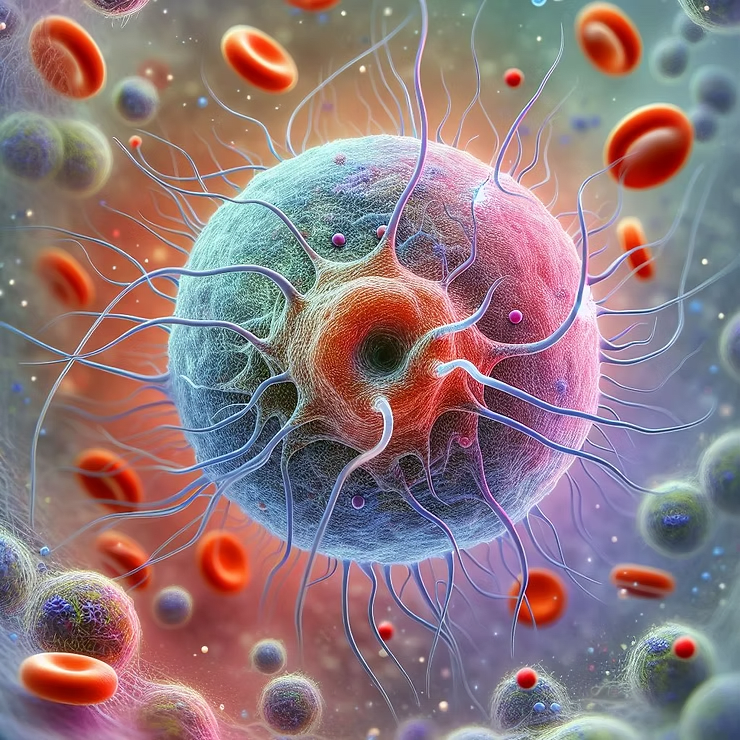
Inflammation: Immediately after a fracture, blood vessels are disrupted, forming a hematoma rich in immune cells, which kickstarts the healing process.
Soft Callus Formation: Within day, cells from the periosteum form a soft cartilage-like tissue, called a callus, which stabilizes the fracture.
Hard Callus Formation: Over time, the soft callus is replaced by hard bone, driven by osteoblasts.
Bone Remodeling: The new bone is remodeled to restore the bone’s original shape and strength.
The Inflammatory Phase:
The initial inflammatory phase is crucial, with immune cells flooding the fracture site. Macrophages, neutrophils, and lymphocytes do more than just clear the debris; they release cytokines and growth factors that coordinate the healing process.
Neutrophils: These first responders initiate an acute inflammatory response, attack microbes, and regulate bone homeostasis.
Macrophages: Key players in inflammation regulation and tissue regeneration, macrophages exist in two functional states: pro-inflammatory (M1) and anti-inflammatory (M2). Initially, M1 macrophages dominate, clearing necrotic tissue and secreting cytokines like TNF-α, IL-1β, and IL-6, which recruit cells needed for repair such as osteoblasts and mesenchymal stem cells (MSC). They also stimulate angiogenesis by releasing VEGF.
T Cells: CD4+ T helper cells release interferon-γ (INFγ) and TNF-α which recruit MSC and immune cells to the fracture site and promote MSC differentiation into osteoblasts. (Maruyama et al., 2020; Schlundt et al., 2015; Yang & Liu, 2021)
Callus Formation:
As the bone repair progresses, a transition from M1 to M2 macrophages occurs. The timing of this transition is critical for the resolution of inflammation and the progression from damage control to tissue regeneration. M2 macrophages release anti-inflammatory cytokines like IL-19 and TGF-β, which suppress inflammation and promote callus formation.
M2 macrophages: These cells play a critical role in promoting MSC differentiation into chondrocytes, which form the soft callus. They also support osteoblast activity, transforming the callus into hard bone, and secrete factors like BMP-2, BMP-4, and TGF-β1, which drive osteoblast proliferation. (Clark et al., 2017; Schlundt et al., 2015; Yang & Liu, 2021)
Angiogenesis: M1 macrophages initiate blood vessel formation through VEGF, while M2 macrophages promote angiogenesis via MMP9 and VEGF. (Schlundt et al., 2015)
Regulatory T cells (Tregs): Tregs help resolve inflammation by releasing IL-10 and TGF-β and regulate osteoclast activity through cytotoxic T-lymphocyte associated protein 4 (CTLA4), ensuring proper bone regeneration. They also inhibit CD4+ T cells to block excessive secretion of IFN-γ and TNF-α, facilitating MSC-based bone healing.
CD8+ T cells: These cells release RANKL to facilitate osteoclast recruitment and activity, which aids in the removal of the fibrin thrombus during callus formation.
B cells: B cells produce osteoprotegerin, which inhibits RANKL, regulating osteoclast differentiation and promoting bone formation.
Bone Remodeling Phase:
In this final phase, immune cells continue to regulate the balance between bone resorption and formation, ensuring the repaired bone gains strength.
M1 and M2 Macrophages: The interplay between M1 and M2 macrophages is crucial in this phase. M1 macrophages promote osteoclastogenesis and bone resorption via RANKL and TNF-α, while M2 macrophages support bone formation by secreting TGF-β and VEGF.
Osteoblasts: These cells, along with immune cells, secrete osteoprotegerin which inhibits RANKL, thereby preventing excessive osteoclast activation and ensuring proper balance between bone resorption and formation. (Baht et al., 2018; Schlundt et al., 2015)
As researchers uncover more about the intricate connections between the immune system and bone healing, new therapeutic possibilities are emerging. Targeting immune pathways could enhance bone repair in patients with fractures and/or bone-related diseases. For patients with compromised immune systems, such as those with autoimmune diseases or undergoing chemotherapy, specialized treatments that support the immune components of bone healing may be particularly beneficial. By leveraging active collaboration between the skeletal and immune systems, future therapies and biomaterials could be designed to improve the bone healing process, especially for vulnerable patients.
Baht, G. S., Vi, L., & Alman, B. A. (2018). The Role of the Immune Cells in Fracture Healing. Current Osteoporosis Reports, 16(2), 138–145. https://doi.org/10.1007/s11914-018-0423-2
Clark, D., Nakamura, M., Miclau, T., & Marcucio, R. (2017). Effects of Aging on Fracture Healing. Current Osteoporosis Reports, 15(6), 601–608. https://doi.org/10.1007/s11914-017-0413-9
Maruyama, M., Rhee, C., Utsunomiya, T., Zhang, N., Ueno, M., Yao, Z., & Goodman, S. B. (2020). Modulation of the Inflammatory Response and Bone Healing. Frontiers in Endocrinology, 11, 386. https://doi.org/10.3389/fendo.2020.00386
Pajarinen J, Lin T, Gibon E, Kohno Y, Maruyama M, Nathan K, Lu L, Yao Z, Goodman SB. Mesenchymal stem cell-macrophage crosstalk and bone healing. Biomaterials. 2019 Mar;196:80-89. doi: 10.1016/j.biomaterials.2017.12.025. Epub 2018 Jan 2. PMID: 29329642; PMCID: PMC6028312.
Schlundt, C., Schell, H., Goodman, S. B., Vunjak-Novakovic, G., Duda, G. N., & Schmidt-Bleek, K. (2015). Immune modulation as a therapeutic strategy in bone regeneration. Journal of Experimental Orthopaedics, 2(1), 1. https://doi.org/10.1186/s40634-014-0017-6
Yang, N., & Liu, Y. (2021). The Role of the Immune Microenvironment in Bone Regeneration. International Journal of Medical Sciences, 18(16), 3697–3707. https://doi.org/10.7150/ijms.61080
© 2025 Molecular Matrix, Inc. All rights reserved.